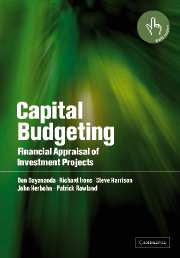Book contents
- Frontmatter
- Contents
- List of figures
- List of tables
- Preface
- 1 Capital budgeting: an overview
- 2 Project cash flows
- 3 Forecasting cash flows: quantitative techniques and routes
- 4 Forecasting cash flows: qualitative or judgemental techniques
- 5 Essential formulae in project appraisal
- 6 Project analysis under certainty
- 7 Project analysis under risk
- 8 Sensitivity and break-even analysis
- 9 Simulation concepts and methods
- 10 Case study in financial modelling and simulation of a forestry investment
- 11 Resource constraints and linear programming
- 12 More advanced linear programming concepts and methods
- 13 Financial modelling case study in forestry project evaluation
- 14 Property investment analysis
- 15 Forecasting and analysing risks in property investments
- 16 Multinational corporations and international project appraisal
- References
- Index
15 - Forecasting and analysing risks in property investments
Published online by Cambridge University Press: 14 May 2010
- Frontmatter
- Contents
- List of figures
- List of tables
- Preface
- 1 Capital budgeting: an overview
- 2 Project cash flows
- 3 Forecasting cash flows: quantitative techniques and routes
- 4 Forecasting cash flows: qualitative or judgemental techniques
- 5 Essential formulae in project appraisal
- 6 Project analysis under certainty
- 7 Project analysis under risk
- 8 Sensitivity and break-even analysis
- 9 Simulation concepts and methods
- 10 Case study in financial modelling and simulation of a forestry investment
- 11 Resource constraints and linear programming
- 12 More advanced linear programming concepts and methods
- 13 Financial modelling case study in forestry project evaluation
- 14 Property investment analysis
- 15 Forecasting and analysing risks in property investments
- 16 Multinational corporations and international project appraisal
- References
- Index
Summary
Property investments put capital at risk. The outcomes almost always vary from the best estimates that we make when evaluating the property. Forecasting outcomes and gauging the risks of not achieving those outcomes are critical in applying capital budgeting techniques to property decisions. This chapter can therefore be seen as a supplement to Chapter 14 which illustrated the methods of property investment analysis.
The early part of Chapter 15 provides guidelines for forecasting cash flows arising from property investments. There will always be doubts about the reliability of forecasts of property rents, operating expenses and capital values, but what is the alternative to forecasting? Purchasing (or leasing) real estate without forecasting cash flows would require that the company or other investor accept the asking or market price (or rent). The ‘going price’ is derived from other people's opinions of the prospects and worth of the property to them. Thus, however difficult forecasting may be, it is surely better than investing blind. The solution lies in selecting the information and methods of forecasting that are most likely to help in estimating cash flows. The most reliable forecasts for real estate often combine the use of quantitative techniques (Chapter 3) and judgemental techniques (Chapter 4).
The later part of this chapter describes ways in which we can assess the risks of not achieving the investment objectives. Risk analysis is needed because of the uncertainty of the cash flows that we forecast.
- Type
- Chapter
- Information
- Capital BudgetingFinancial Appraisal of Investment Projects, pp. 274 - 296Publisher: Cambridge University PressPrint publication year: 2002



